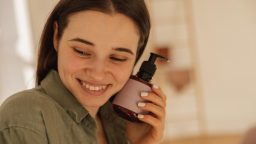Acne is one of the most common skin conditions among teenagers, affecting nearly 85% of teens at some point. It can be frustrating, especially when it feels like no matter what you try, those pesky pimples just keep popping up. But don’t worry—there are plenty of acne solutions that can help you manage breakouts and achieve clearer, healthier skin. Here are some effective acne solutions every teen should know, from skincare tips to lifestyle changes, to help you take control of your skin.
- Stick to a Simple Skincare Routine
When it comes to treating acne, consistency is key. But that doesn’t mean you need an elaborate 10-step skincare routine. In fact, a simple routine can often be more effective.
- Cleanse: Start by using a gentle cleanser that’s designed for acne-prone skin. Avoid harsh scrubs or cleansers with alcohol, as they can dry out your skin and make acne worse. Use a cleanser that helps remove excess oil without irritating your skin. Wash your face twice a day—once in the morning and once before bed—to remove dirt, oil, and impurities.
- Tone: Consider using an alcohol-free toner after cleansing to help balance your skin’s pH levels. Toners can help close pores and remove any leftover dirt or oil that the cleanser might have missed.
- Moisturise: Many teens with acne think that moisturising will make their breakouts worse, but this isn’t true. Even oily skin needs hydration. Use a non-comedogenic (meaning it won’t clog your pores) moisturiser to keep your skin hydrated. This can actually help prevent your skin from producing too much oil, which could lead to more breakouts.
- Spot Treatment for Breakouts
When pimples pop up, having an effective spot treatment can make a big difference. Look for products that contain acne-fighting ingredients like salicylic acid, benzoyl peroxide, or sulfur. These ingredients can help reduce inflammation, kill acne-causing bacteria, and speed up the healing process.
- Salicylic Acid: This beta-hydroxy acid (BHA) helps to exfoliate the skin, unclog pores, and reduce redness. It’s ideal for treating blackheads and whiteheads.
- Benzoyl Peroxide: This is a powerful ingredient that kills the bacteria responsible for acne. It’s most effective for inflamed, cystic acne. Be cautious, though—benzoyl peroxide can sometimes dry out the skin, so start with a lower concentration and gradually increase if needed.
- Sulfur: Often used in spot treatments and masks, sulfur can help dry out acne pimples without irritating the skin.
- Don’t Pick or Squeeze Your Pimples
It might be tempting to pop or pick at your pimples, but doing so can actually make the situation worse. Squeezing pimples can push bacteria deeper into the skin, which could lead to more inflammation and scarring. Instead of picking, focus on keeping your skin clean and applying acne treatments directly to the spots.
- Use Non-Comedogenic Makeup
For many teens, makeup is a fun way to express themselves, but it can also contribute to breakouts if the wrong products are used. Non-comedogenic makeup is designed specifically not to clog pores, which can help prevent new acne from forming.
- Choose oil-free foundations and makeup products that are labelled “non-comedogenic.” This includes moisturisers, concealers, and powders.
- Always remove makeup before bed. Sleeping in makeup can block your pores, leading to breakouts. Use a gentle makeup remover or micellar water to cleanse your skin thoroughly before going to sleep.
- Be Mindful of Your Diet
While diet isn’t the sole cause of acne, what you eat can affect your skin. Studies have shown that certain foods can trigger breakouts, so it’s important to pay attention to how your skin reacts to certain foods.
- Limit dairy: Some studies suggest that dairy products, particularly milk, can contribute to acne. If you think dairy may be triggering your breakouts, try cutting back for a few weeks to see if your skin improves.
- Cut back on refined sugars and processed foods: High-glycemic foods, like sugary snacks and processed carbohydrates, can cause a spike in blood sugar levels, which in turn may lead to acne. Focus on eating whole foods like fruits, vegetables, whole grains, and lean proteins.
- Hydrate: Drinking plenty of water is essential for keeping your skin healthy. Water helps flush toxins from your body, which can improve your complexion and keep your skin clear.
- Manage Stress
Stress is another factor that can contribute to acne. When you’re stressed, your body releases hormones like cortisol that can increase oil production in your skin, leading to clogged pores and breakouts. Finding ways to manage stress can help keep your skin in check.
- Exercise: Regular physical activity helps reduce stress and increases blood circulation, which can give your skin a healthy glow.
- Sleep: Getting enough sleep is also essential for stress management. Lack of sleep can lead to higher cortisol levels, which may contribute to acne.
- Relaxation techniques: Practices like deep breathing, meditation, or even hobbies like drawing or listening to music can help lower stress levels and keep your skin calm.
- Consult a Dermatologist if Needed
If your acne is persistent, severe, or causing you distress, it may be time to consult a dermatologist. A dermatologist can provide personalised advice and may recommend prescription treatments like topical retinoids, antibiotics, or even oral medications like isotretinoin (for severe acne). They can also guide you on the best acne skincare routine for your specific skin type.
Conclusion
Acne can be tough to deal with, but there are plenty of solutions to help you manage it. The key to tackling breakouts is consistency—stick to a simple skincare routine, use spot treatments when necessary, and avoid the temptation to pick at your skin. By being mindful of your diet, managing stress, and choosing the right skincare products, you can take control of your acne and feel more confident in your own skin. Remember, everyone’s skin is different, so it may take some trial and error to find what works best for you. Be patient, and don’t be afraid to seek professional help if needed. With the right approach, clear skin is within reach!





